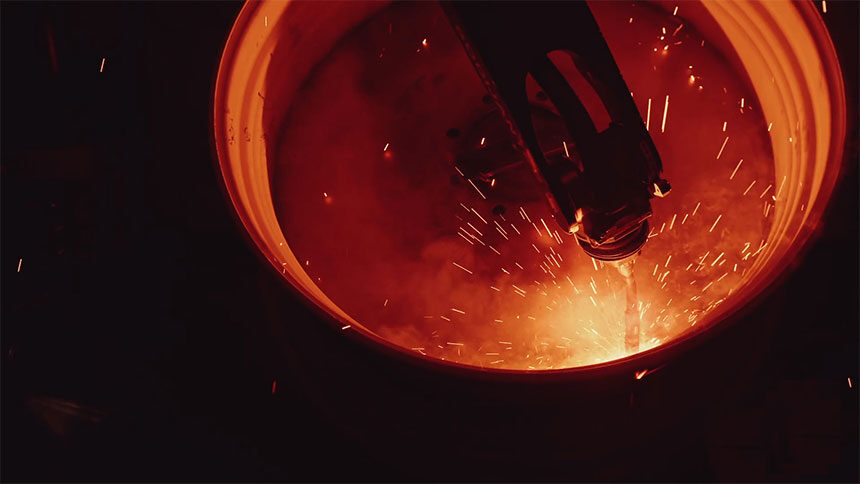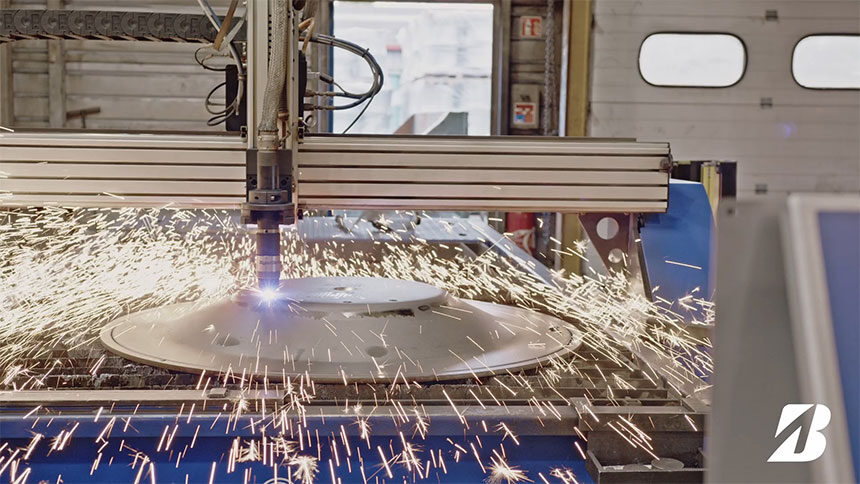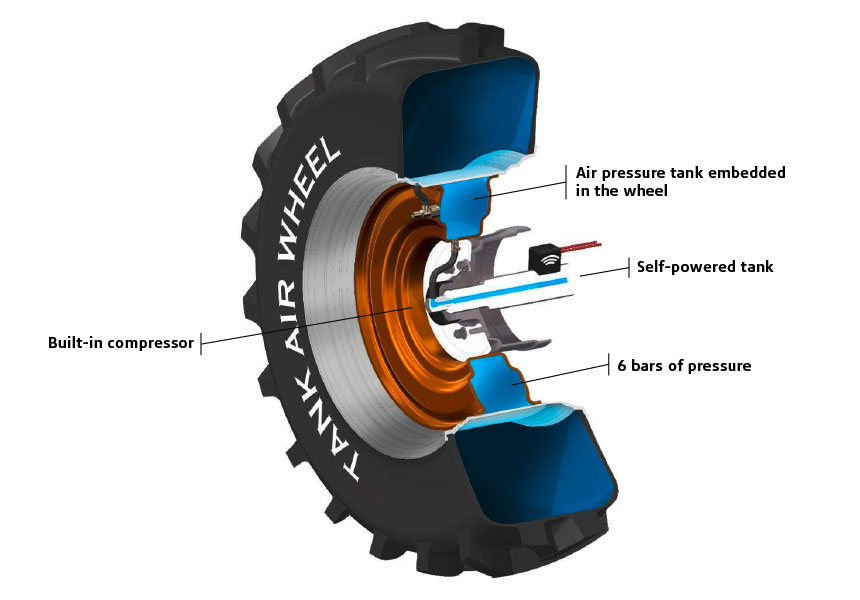As the rim is the tyre’s vital ally, there is little point having a good tyre with a bad rim. Average rims are intended for average use, which is the heart of the problem.
Looking for an average solution to be able to do everything; average pressure, average tyre, average rim, is quite the opposite of precision farming.
If you have decided to opt for more high-tech wide tyres, you certainly have a good reason: soil preservation, improvement of traction, increased load…
For your wheel/tyre configuration to be optimal, you must improve the rims to obtain perfectly homogenous wheels. They will then be able to keep all their promises in terms of productivity, efficiency and soil preservation.There are many rim, wheel and tyre configurations that are considered compatible, but how do you work it all out?
In this article you will find the right indications to help choose the rim that is most suitable for wide tyres.
1. Which rim to choose for wide tyres?
You have two approaches possible when you change your tyres:
- Either you give priority to the rim to reduce costs and you choose among the tyre models compatible with the size of your current rims;
- Or you give priority to the tyre to improve productivity as much as possible. You will certainly have to change the rim to obtain an optimal configuration, with a constant productivity gain over the tyre lifespan.
Which rim width is compatible with which tyre width?
For each tyre model, the manufacturer recommends a rim model which corresponds perfectly with the width of the tyre chosen.
There are compatible or authorised rim models which have widths similar or close to the recommended rim model.
With these compatible models in general you won’t have any problem, however there is an adaptation necessary and the tyre/rim configuration will be less precise than with the recommended model.

2. Width of the rim in inches, this is the figure associated with the profile: W15, DW23, TW18…
It is possible to increase the width by modifying a rim, but this type of operation is extremely tricky and precise. It can only be done by an approved service provider with the equipment necessary to carry out such operations in compliance with applicable standards.

an expert in adapting premium rims
BEWARE, a rim which is unsuitable or which has the wrong width for the tyre can lead to many problems, such as loss of pressure, rotation of the tyre on the rim or even the tyre coming off the rim, resulting in the immobilisation of your vehicle.
Which rim diameter to choose
You can find several tyre sizes with different rim diameters.
You have two options as far as the rim is concerned, either to increase the diameter of the rim, or reduce the diameter of the rim:
- Increasing the rim diameter from 38 to 42 inches, for example, will allow you to obtain better traction while reducing fuel consumption, with the same engine power.
- On the other hand, reducing the diameter of your rim will allow you to increase the volume of air available and therefore to increase the load, or reduce pressure with the same load and protect your soil.

with wider tyres makes it possible to increase the load
What types of rim to choose: welded fixed track or track adjustable rims?
There are different types of profiles, W, DW, TW… which make it possible to reinforce the overall rigidity of the rim. The W profile is the most simple, and also the most rigid.
There are also different categories of rim: fixed welded rims and track adjustable rims with an adjustable disc.

- Fixed track welded rims are robust and ideal for large sizes and very heavy loads. They are more resistant but do not allow any track adjustments for the tractor.
- Track adjustable rims, on the other hand, offer greater flexibility. You can adjust the width of your tractor track to adapt to different crops, different field configurations, gain rows on your plots of land or optimise your productivity by driving precisely between young seedlings.

What tyre size to choose?
The choice of tyre size depends on several factors such as the size of the machine, the type of farm and the type of operations you carry out.
Extra-wide900 mm tyres, for example, are perfectly adapted to large field crop farms of over a hundred hectares. These tyre models offer a high load capacity and better traction.
Wide, more standard tyres of 580 mm can also be very efficient, but for average size farms as they obviously cannot handle the same loads.
The benefits of wide tyres
The width of the tyres plays an important role in improving tractor performances. Wider tyres spread the load to the ground better, which reduces compaction and improves traction.
In addition, they can carry heavier loads to allow you to work with bigger implements and save time in every field.
2. The advantages of a premium rim for your wide tyres
If you work on difficult land (clay soil), steep or sloping land or rough terrain, it will be important to be certain of the quality of your wheels to improve vehicle stability and adherence.
Premium rims ensure this balance and when associated with wide tyres you will be able to work in total safety while improving the efficiency of your labours.
Premium rims: Comply with standards during the design phase
A large premium rim complies with ETRTO standards (legislation governing rims and tyres). It is designed to adapt to the exact dimensions of the tyre.
With this compliance, you are sure to obtain a perfect fit. This improves tyre wear life while guaranteeing optimal performance all around.
Quality of materials and adjustment precision
The premium rim is produced using standardised metals, components and welding. This very strict design guarantees the level of quality and prevents any rim breakage. It is adapted to your tyre model, with an adjusted disc width and millimetre precision offset settings.
With a quality rim, you obtain greater solidity and reliability, which are essential for intensive agricultural labours.

Plasma cutting and precision welding on a rim disc
Associate your high-tech tyres with premium rims
Lower quality rims can cancel out all the benefits of premium tyres.
If you have chosen high-tech tyres, premium rims will allow you to maximise the benefits. They ensure an optimal performance capacity for your tyres thanks to their precise, adapted design.
A perfect match between tyre and rim
If you choose a premium rim, there will be a perfect match between the tyre and the rim. The tyre bead will be perfectly airtight and protected. You will be able to work at low pressure without any risk of coming off the rim.
The bead will not slip on the rim seat, ensuring a longer lifespan.
You will therefore be able to work efficiently at all times, even in the harshest conditions.
3. What are the limitations of rims for wide tyres?
Choosing the right rim is also a question of structure and mechanical resistance.
Track adjustable rims, while very versatile, may have limitations in terms of load and speed for very heavy agricultural machinery equipped with extra-widetyres.
This type of machine requires a high level of torque. With bolted-on track adjustable rims, whether there are 6 or 12 bolts, the distribution of forces takes place at the level of each bolt.
This can cause problems for very heavy vehicles equipped with extra-wide rims or extra-wide tyres. For example: 900/60 R32 rear tyre with a DW30B rim and 710/70 R42 front tyre with a DW25B rim, above all when driving at over 50 km/h on the road, when loaded.
On the other hand, welded rims offer a more solid and reliable solution, which is more suitable for work conditions involving extra-wide tyre equipment.
4. Choose Tank Air Wheel rims and wide VF tyres for a perfect set-up
To optimise the efficiency of your agricultural operations, it is essential to choose a good tyre-rim-equipment configuration.
VF VT-TRACTOR tyres, the Tank Air Wheel rim and a central tyre inflation system (CTIS) make a perfect alliance.

The VF VT-TRACTOR tyre
The VF VT-TRACTOR tyre is designed to protect your soil and can work at very low inflation pressures, as low as 0.8 bar. This suppleness makes it possible to reduce soil compaction significantly.
At low pressure, the weight of the tractor is effectively spread more evenly over a larger contact patch with the ground. As such you protect the structure of the soil and the growth of your crop roots.

The Tank Air Wheel
This revolutionary technology, launched by Sodijantes Industrie, builds a compressed air tank directly into the wheel, making it possible to inflate agricultural tyres in less than a minute without getting out of the tractor cab.
Thanks to its automated, in-built compressor, the Tank Air Wheel can go from a tyre pressure of 0.8 bar to 1.8 bar almost instantaneously.
This system saves precious time and also extends the tyre lifespan by up to 50% by adapting tyre pressure depending on the terrain. Imagine working at low pressure to protect your soil, then increasing pressure for transport by road in a matter of seconds.

immediately available in your tractor rims
The central tyre inflation system
The central tyre inflation system finishes off this ideal configuration. It allows you to adjust the pressure in your tyres on the fly, directly from your tractor cab, depending on the conditions in the field and the activities you intend to carry out.
On the road, higher pressure reduces rolling resistance, saving up to 30% on fuel.
In the fields, lower pressure protects the soil and improves traction. No further need for a compromise between energy efficiency and agricultural performance: the CTIS adapts instantly to your needs.
If you are thinking about replacing your old tyres by new wider agricultural tyres, you should also invest in suitable rims.
This will allow you to get the most from your new tyres and improve machine performance. To go even further in terms of performance capacity, the combination of the VT VF-TRACTOR tyre and the Tank Air Wheel with CTIS is an ideal and complete solution.
The Bridgestone-agriculture.eu blog is written and administered by tractor tyre experts who are available to provide you with the advice you need on the subject of your agricultural tyres. They allow you to maximise your productivity with information on all subjects linked to tyres: Cheap tractor tyres — Technical data for agricultural tyres — Air pressure advice — Solutions to avoid soil compaction — Sprayer tyre pressure — Why and how to ballast your tractor tyres — When to use dual wheels — The mechanical causes of abnormal wear — Cheap agricultural tyres – etc.
To learn more and boost your farm's profits, Bridgestone-Agriculture is offering you a free, detailed white paper that explains the essential role your agricultural tyres play in your productivity.
Most people who read this article have also read some of the following articles:
- 5 essential techniques to optimise your agricultural tyres
- Managing the load transfer to the front tyres in polycropping
- What are the signs of an incorrect lead ratio?
- Impact of the dynamic rolling circumference of agricultural tyres
- What is the impact of the section width of your agricultural tyres
- Do my tractor tyres have a wide enough footprint?
- Can my agricultural tyres help reduce my fuel consumption?
- Does improper lead invalidate your agricultural tyre warranty?
- How can you manage the rolling resistance in agricultural tyres better?
- What are agricultural tyres’ high-strain zones?
This information is intended only to make you aware of the technical and functional aspects of agricultural tires and their use. It does not allow you to make a judgment or a definitive conclusion on a given problem. Only your agricultural tire expert is able to make a technical assessment and take a final decision, case by case.
Leave a
commentary
Your email address will not be published.
Required fields are indicated with *








